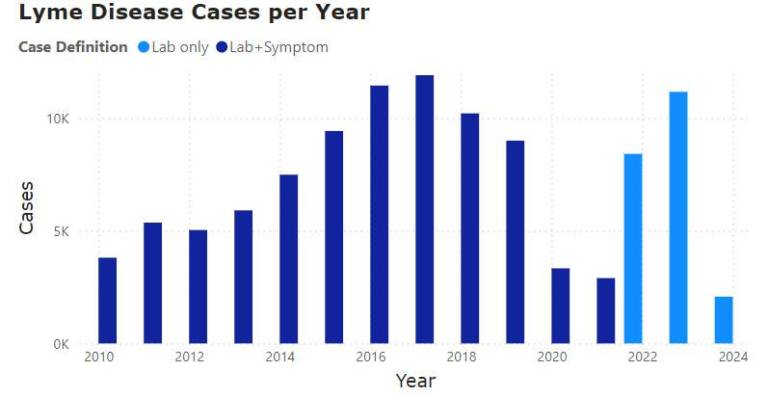DOH launches new dashboard to help prevent tickborne diseases
Milford. Pike County’s Lyme disease rate is 46.7 cases per 100,000 people.

Just in time for National Lyme Disease Awareness Month, the Pennsylvania Department of Health this week launched a new online dashboard to provide Pennsylvania residents and health care providers with information about tickborne diseases. The dashboard was designed for Pennsylvanians to use themselves, so they can see where ticks are prevalent and be prepared to take appropriate precautions while enjoying outdoor activities.
The tickborne diseases dashboard allows visitors the opportunity to review the latest state data on tickborne disease activity, such as Lyme disease. The data include case counts across Pennsylvania and cases per 100,000 residents per county to understand the prevalence of ticks.
For example, the dashboard shows Pike County having a rate of 46.7 cases of Lyme disease per 100,000 people, which is lower than neighboring Wayne County, which had a rate of 93.3 cases per 100,000 people.
”Pennsylvania has incredible outdoor recreational opportunities, and we want to provide as much information as possible for residents to enjoy them safely,” said Acting Secretary of Health Dr. Debra Bogen. “Taking appropriate precautions can help avoid Lyme and other tickborne diseases that can lead to serious illness. As a pediatrician, I always recommend doing a tick check after playing outside, especially for children and pets.”
Lyme disease is the most commonly reported tickborne disease in Pennsylvania and many other states, but there are several other diseases ticks can carry. In 2022, Pennsylvania ranked ninth in the United States for the number of Lyme disease cases reported by population. Although tickborne diseases can occur any time of the year, cases increase from April through August. In 2022, 8,413 cases were reported in Pennsylvania, representing an incidence of 64.9 cases/100,000 persons.
The information is based on laboratory reports the Department receives directly from lab-based reporting. Prior to 2022, Lyme cases were classified based on laboratory and clinical information obtained from health care providers. Since that date, clinical information is no longer required, and Lyme cases are reported based only on laboratory criteria.
Tick bite prevention and removal
Residents can reduce the likelihood of a tick bite by:
• walking in the center of trails and avoiding areas with high grass and leaf litter;
• using EPA-approved insect repellents on exposed skin;
• using products that contain 0.5% permethrin to pre-treat shoes, clothing, and gear;
• wearing light-colored clothing, which will make it easier to see crawling ticks;
• conducting full-body tick checks (including pets) after spending time in tick habitats;
• bathing or showering within two hours after coming indoors; and
• placing clothing worn outdoors in the dryer on high heat for 10 minutes to kill ticks.
If an attached tick is found, it should be promptly removed using fine-tipped tweezers. The tick should be grasped as close to the skin’s surface as possible and pulled upward with steady, even pressure.
Find the Tickborne Disease Dashboard and more information on tickborne diseases at the Department of Health’s website.